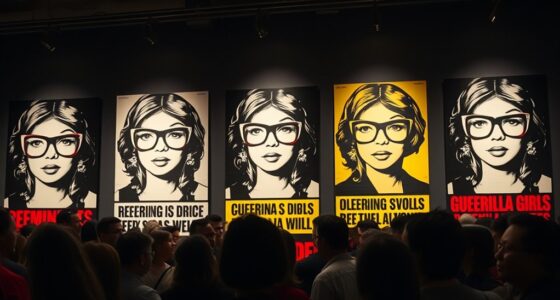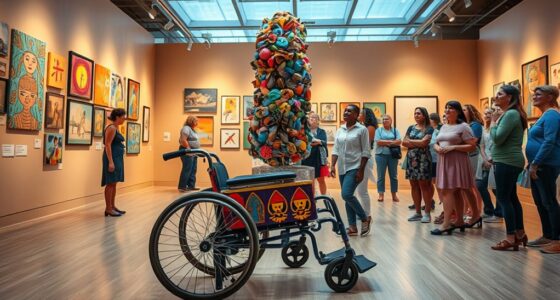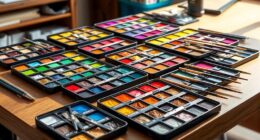Political printmaking started with Goya’s provocative engravings that exposed societal injustices and challenged authority. Over time, techniques like etching and lithography helped activists spread messages for social resistance. Today, digital tools and remix culture enable faster, more interactive commentary. This evolution broadens participation and expands reach, blending traditional art with modern technology. To discover how this creative journey continues and shapes activism, explore the full story.
Key Takeaways
- Goya’s engravings revolutionized political printmaking by exposing societal injustices and inspiring future artists’ activism.
- Techniques like etching, lithography, and color theory enhanced the impact and symbolism of political prints.
- Digital media and remix culture now enable rapid, layered, and participatory political commentary through memes and online images.
- Visual symbolism and satire remain vital in amplifying political messages across historical and digital platforms.
- Combining traditional methods with digital tools offers new opportunities for activism, audience engagement, and preserving printmaking’s relevance.
The Origins of Political Printmaking: Goya’s Engravings and Their Impact
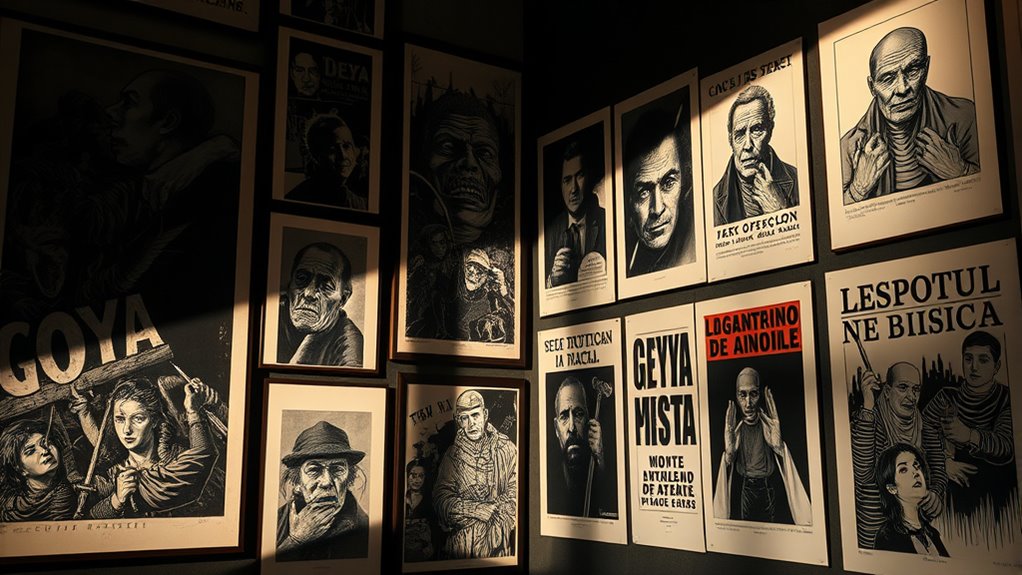
Goya’s engravings mark a pivotal moment in the history of political printmaking, as they vividly captured the turmoil and injustices of his time. His etchings, often infused with sharp political satire, challenged authority and exposed societal flaws. By using this medium, Goya gave voice to the oppressed and criticized the abuses of power without direct confrontation. His works, such as “The Disasters of War,” reveal brutal realities, forcing viewers to confront uncomfortable truths. This approach helped establish political printmaking as a powerful tool for social commentary. Goya’s ability to blend art with activism inspired future generations of artists to use printmaking for political expression, cementing its role as a means of resistance and reform. Additionally, the development of high-quality printing techniques during and after Goya’s era enhanced the ability of artists to produce impactful and widely accessible political prints.
Techniques and Strategies in Historical Political Printmaking

Historical political printmakers employed a range of techniques to effectively convey their messages and influence public opinion. They utilized print techniques like etching, engraving, and lithography to create detailed, impactful images. Mastery of color theory also played a pivotal role; artists used contrasting colors and shading to highlight key figures or ideas, amplifying emotional responses. These strategies enabled them to craft visuals that communicated complex political messages swiftly and clearly. By manipulating line work, textures, and color schemes, printmakers could emphasize satire, criticism, or propaganda. Their careful application of print techniques and understanding of color theory allowed them to produce compelling images that resonated with viewers, shaping public discourse and mobilizing support or opposition within society. Additionally, understanding the history of printmaking enhances appreciation of how these techniques evolved to meet the needs of political commentary over time.
The Role of Printmaking in Social Movements and Political Resistance

Printmaking has long been a powerful tool for amplifying marginalized voices and challenging dominant narratives. It mobilizes public sentiment by spreading bold images and messages that resonate widely. Through this, artists and activists can inspire action and foster solidarity in social movements. Additionally, printmaking techniques such as lithography and etching have historically been used to produce visual propaganda, making complex ideas accessible and impactful to diverse audiences.
Amplifying Marginalized Voices
Printmaking has long served as a powerful tool for marginalized communities to share their stories and challenge dominant narratives. You can see this in satirical caricatures that mock oppressive systems, giving voice to those silenced by authority. Underground posters serve as bold, accessible platforms for activism, often created anonymously to protect creators and reach wider audiences. These prints amplify marginalized perspectives, bypassing mainstream media filters. They empower communities to voice grievances, inspire solidarity, and foster resistance. By using accessible materials and provocative imagery, printmakers turn art into a weapon against injustice. You might notice how these visual strategies appeal directly to viewers, encouraging them to question authority and recognize the power of collective action. Additionally, the materials and techniques used in printmaking make it an affordable and adaptable medium for activists with limited resources. Ultimately, printmaking becomes a crucial instrument for marginalized voices to be heard and understood.
Mobilizing Public Sentiment
How do visual images in printmaking rally people around a cause? They cut through complex messages, delivering powerful, immediate impressions. Satirical satire uses humor and irony to criticize authority or injustice, making messages memorable and shareable. Propaganda posters, on the other hand, evoke strong emotions, uniting viewers under a common banner. Both forms tap into public sentiment, shaping opinions and encouraging action. Printmakers create images that stir outrage, hope, or solidarity, turning passive viewers into active participants. Their work spreads quickly and widely, especially during social movements or political resistance. By combining striking visuals with clear messaging, printmaking becomes a tool to mobilize communities, challenge power structures, and inspire collective action.
Transition to Modern Styles: The Evolution of Political Printmaking

As artistic movements evolved in the late 19th and early 20th centuries, political printmaking shifted away from traditional, detailed illustrations toward more modern, expressive styles. You notice artists embracing abstract expressionism, using bold forms and spontaneous brushwork to convey intense emotion and political urgency. This style emphasizes personal vision over realism, allowing artists to challenge conventions and provoke thought. Later, digital abstraction emerged, transforming how messages are communicated through technology. You see printmakers experimenting with digital tools, creating layered, non-representational images that reflect complex political realities. These modern styles move beyond literal depictions, focusing on emotion, perception, and conceptual depth, therefore broadening the scope of political printmaking and engaging viewers in new, innovative ways. Additionally, visual communication techniques have become more prevalent, facilitating the dissemination of political messages across diverse audiences.
Contemporary Artists and the Digital Age of Political Commentary
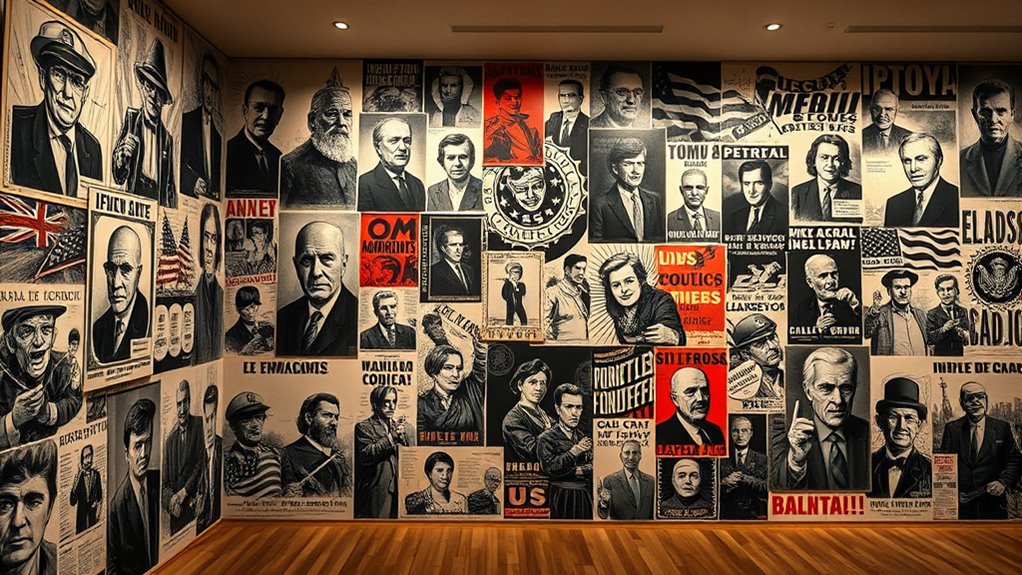
You see how social media amplifies political messages through striking visuals and quick sharing. Artists now remix images and memes to challenge viewers and spark conversations instantly. This digital approach transforms traditional printmaking into a dynamic tool for contemporary political commentary. Additionally, the use of visual storytelling in digital media allows artists to communicate complex political issues in accessible and engaging ways.
Social Media’s Visual Power
Social media has revolutionized political printmaking by providing artists with instant access to a global audience. You can now leverage visual storytelling to craft powerful messages that resonate instantly. Memes spread rapidly, amplifying political commentary across platforms, making art more accessible and immediate. This digital landscape transforms traditional printmaking into dynamic, shareable content. To imagine this, consider the following:
| Traditional Printmaking | Digital Political Art |
|---|---|
| Limited distribution | Viral meme dissemination |
| Handcrafted editions | Instant sharing |
| Physical galleries | Social media feeds |
| Text-heavy prints | Visual punch in seconds |
| Slow dissemination | Rapid global reach |
This shift empowers you to engage audiences directly, fostering conversation and activism through compelling, timely images. Additionally, understanding the traits of female covert narcissists can help artists and viewers recognize manipulation and underlying motives in political imagery.
Remix Culture and Memes
Remix culture has transformed political commentary in the digital age by enabling artists and activists to repurpose existing images, symbols, and memes to craft new, impactful messages. Through digital remixing, you can take familiar visuals and reshape them to highlight current issues or challenge authority. Meme culture accelerates this process, making content easily shareable and highly adaptable. By combining humor, satire, and sharp critique, creators engage audiences quickly and effectively. You’re encouraged to remix famous artworks, political icons, and social symbols, creating layered messages that resonate across online communities. This approach democratizes political expression, allowing anyone with internet access to contribute to ongoing debates. In this way, remixing and memes become powerful tools, transforming traditional printmaking into a dynamic, participatory form of digital activism. Additionally, the use of visual symbolism plays a crucial role in amplifying these messages and connecting with diverse audiences worldwide.
The Future of Political Printmaking: Challenges and Opportunities
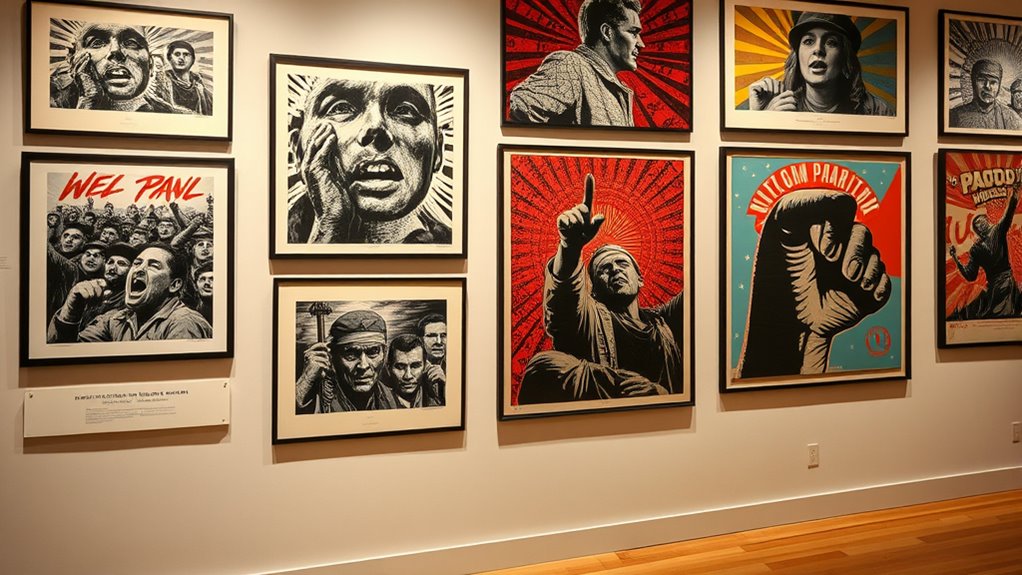
As digital technology continues to evolve, political printmaking faces both significant challenges and exciting opportunities. Technological innovation enables you to reach wider audiences instantly, expanding your impact beyond traditional print. You can leverage digital platforms for audience engagement, creating interactive and shareable content that amplifies political messages. Additionally, understanding sound healing science can inspire innovative approaches to incorporating auditory elements into your work, creating multisensory experiences. However, this shift also raises questions about authenticity and artistic integrity, as digital tools may diminish the tactile, handcrafted quality of printmaking. To stay relevant, you need to adapt by blending traditional techniques with digital methods, fostering genuine connections with your audience. Embracing these opportunities allows you to innovate within the medium, ensuring political printmaking remains a powerful form of commentary in a rapidly changing media landscape.
Frequently Asked Questions
How Did Political Printmaking Influence Public Opinion Historically?
Political printmaking shaped public opinion by using satirical imagery and propaganda strategies that captured people’s attention and stirred emotions. You see, these prints often challenged authority or highlighted societal issues, making complex ideas more accessible. They influenced opinions by sparking debate and encouraging viewers to question the status quo. As a result, printmakers became powerful agents of change, swaying public sentiment and inspiring movements.
What Materials Are Most Common in Traditional Political Printmaking?
Materials in traditional political printmaking are like essential tools for a craftsman. You mostly use sturdy paper techniques, such as hand-made or lithographic paper, and a variety of ink varieties, including oil-based or water-based inks. These materials guarantee durability and vividness, allowing your message to stand out. Combining quality paper and diverse inks helps produce powerful, lasting images that effectively communicate political messages across different audiences.
How Do Political Printmakers Choose Their Subjects and Messages?
You choose your subjects and messages by considering current events, social issues, or political figures that resonate with your audience. You use symbolic imagery to evoke emotions and convey complex ideas quickly, often employing propaganda techniques to influence opinions. Your goal is to create impactful prints that spark discussion or inspire action, ensuring your message is clear and compelling through visual storytelling and strategic imagery.
What Ethical Considerations Arise in Political Printmaking Today?
Ever wondered about the ethics behind political printmaking today? You need to consider censorship concerns and representation ethics. You might face dilemmas about accurately portraying sensitive issues without spreading misinformation or offending groups. How do you balance free expression with respect for diverse perspectives? Staying mindful of these ethical considerations helps ensure your work promotes honest dialogue while respecting boundaries, fostering responsible activism through your art.
How Can Emerging Technologies Enhance Political Printmaking’s Effectiveness?
You can enhance political printmaking’s effectiveness by leveraging digital techniques, which allow you to create more intricate and engaging visuals quickly. Incorporating interactive displays invites your audience to participate actively, deepening their understanding and emotional connection to your message. These technologies make your prints more accessible and impactful, ensuring your political commentary resonates broadly and encourages dialogue, making your work both innovative and influential in today’s digital age.
Conclusion
As you navigate the world of political printmaking, remember it’s more than art—it’s a voice echoing through history. Like a torch passing from Goya’s engravings to today’s digital comments, this craft empowers you to challenge, inspire, and ignite change. Embrace the legacy of resistance and see yourself as part of a vibrant dialogue—where every print carries the power to shape tomorrow’s world. After all, your voice can turn images into revolutions.




